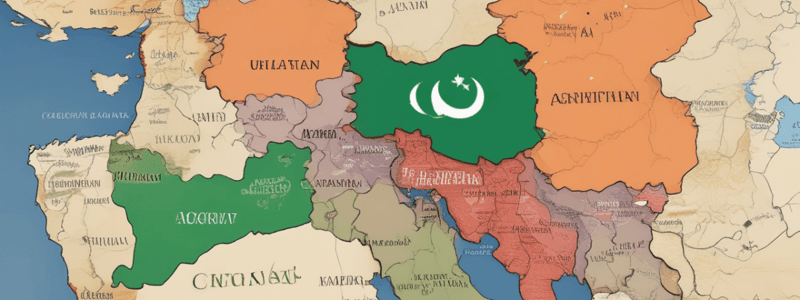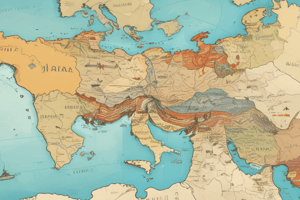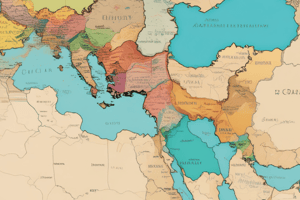Podcast
Questions and Answers
What has been the central issue of contention between Afghanistan and Pakistan?
What has been the central issue of contention between Afghanistan and Pakistan?
Afghanistan's refusal to recognize the Durand Line and its support for a separate Pushtun state, Pakhtunkhwa.
How has Pakistan leveraged its relationship with the United States to bolster its military capabilities?
How has Pakistan leveraged its relationship with the United States to bolster its military capabilities?
Pakistan has used its relationship with the US to bolster its military capabilities.
What was the significance of Afghanistan's alignment with the Soviet Union in the 1950s and 60s?
What was the significance of Afghanistan's alignment with the Soviet Union in the 1950s and 60s?
Afghanistan's alignment with the Soviet Union further complicated the relationship between Afghanistan and Pakistan.
Who were some key political figures in Afghanistan and Pakistan that played crucial roles in shaping the country's stance?
Who were some key political figures in Afghanistan and Pakistan that played crucial roles in shaping the country's stance?
What has been the role of external powers in the conflict between Afghanistan and Pakistan?
What has been the role of external powers in the conflict between Afghanistan and Pakistan?
What is the current status of the conflict between Afghanistan and Pakistan?
What is the current status of the conflict between Afghanistan and Pakistan?
What was the significance of the 1949 event in which Afghanistan formally renounced the Durand Line?
What was the significance of the 1949 event in which Afghanistan formally renounced the Durand Line?
What was the impact of Pakistan's 'One Unit' scheme on Afghanistan?
What was the impact of Pakistan's 'One Unit' scheme on Afghanistan?
What is one of the consequences of the Afghanistan-Pakistan conflict?
What is one of the consequences of the Afghanistan-Pakistan conflict?
What is the historical root of the Afghanistan-Pakistan conflict?
What is the historical root of the Afghanistan-Pakistan conflict?
What has been the impact of external powers on the conflict?
What has been the impact of external powers on the conflict?
What is one of the reasons why the conflict has persisted?
What is one of the reasons why the conflict has persisted?
What has been the result of the decades of proxy wars and shifting alliances?
What has been the result of the decades of proxy wars and shifting alliances?
What is another consequence of the conflict, in addition to periodic violence?
What is another consequence of the conflict, in addition to periodic violence?
What is the main reason for the conflict's persistence, according to the text?
What is the main reason for the conflict's persistence, according to the text?
What is the overall impact of the conflict on the region?
What is the overall impact of the conflict on the region?
What is the geographical root cause of the Afghanistan-Pakistan conflict?
What is the geographical root cause of the Afghanistan-Pakistan conflict?
Which province, predominantly Pushtun, was allocated to Pakistan during the 1947 partition of India?
Which province, predominantly Pushtun, was allocated to Pakistan during the 1947 partition of India?
How did the rugged, mountainous terrain of the region impact the conflict?
How did the rugged, mountainous terrain of the region impact the conflict?
When did the modern interstate conflict between Afghanistan and Pakistan begin?
When did the modern interstate conflict between Afghanistan and Pakistan begin?
What was the outcome of the 1949 Afghan renunciation of the Durand Line as a legitimate border?
What was the outcome of the 1949 Afghan renunciation of the Durand Line as a legitimate border?
What was the effect of Afghanistan seeking Soviet aid after Pakistan cut off trade routes?
What was the effect of Afghanistan seeking Soviet aid after Pakistan cut off trade routes?
What event marked a critical point in the conflict during the 1970s?
What event marked a critical point in the conflict during the 1970s?
What is the primary focus of the political dynamics of the conflict?
What is the primary focus of the political dynamics of the conflict?
What geographical feature has complicated border control and facilitated insurgency and cross-border militancy in the Afghanistan-Pakistan conflict?
What geographical feature has complicated border control and facilitated insurgency and cross-border militancy in the Afghanistan-Pakistan conflict?
What event in 1979 marked a critical point in the Afghanistan-Pakistan conflict?
What event in 1979 marked a critical point in the Afghanistan-Pakistan conflict?
Why did Afghanistan seek Soviet aid in the 1950s and 60s?
Why did Afghanistan seek Soviet aid in the 1950s and 60s?
What was the outcome of the 1947 partition of India in regards to the North West Frontier Province (NWFP)?
What was the outcome of the 1947 partition of India in regards to the North West Frontier Province (NWFP)?
What is the name of the border demarcation established in 1893 between British India and Afghanistan?
What is the name of the border demarcation established in 1893 between British India and Afghanistan?
In what century did the roots of the Afghanistan-Pakistan conflict begin?
In what century did the roots of the Afghanistan-Pakistan conflict begin?
What was the result of Afghanistan's rejection of the Durand Line as a legitimate border in 1949?
What was the result of Afghanistan's rejection of the Durand Line as a legitimate border in 1949?
What is the primary ethnic group affected by the Afghanistan-Pakistan conflict?
What is the primary ethnic group affected by the Afghanistan-Pakistan conflict?
What role have external powers played in the Afghanistan-Pakistan conflict?
What role have external powers played in the Afghanistan-Pakistan conflict?
What are the ongoing consequences of the Afghanistan-Pakistan conflict?
What are the ongoing consequences of the Afghanistan-Pakistan conflict?
How have the decades of proxy wars and shifting alliances affected the conflict?
How have the decades of proxy wars and shifting alliances affected the conflict?
What is the root cause of the Afghanistan-Pakistan conflict?
What is the root cause of the Afghanistan-Pakistan conflict?
What has been the impact of the conflict on the region?
What has been the impact of the conflict on the region?
Why has the conflict persisted over time?
Why has the conflict persisted over time?
What are the primary drivers of the conflict between Afghanistan and Pakistan?
What are the primary drivers of the conflict between Afghanistan and Pakistan?
What is the overall outcome of the decades-long conflict between Afghanistan and Pakistan?
What is the overall outcome of the decades-long conflict between Afghanistan and Pakistan?
What is the main factor behind Afghanistan's refusal to recognize the Durand Line?
What is the main factor behind Afghanistan's refusal to recognize the Durand Line?
How did the Cold War era impact the Afghanistan-Pakistan conflict?
How did the Cold War era impact the Afghanistan-Pakistan conflict?
What is the significance of the year 1947 in the context of the Afghanistan-Pakistan conflict?
What is the significance of the year 1947 in the context of the Afghanistan-Pakistan conflict?
What was the impact of the Soviet invasion of Afghanistan on the conflict?
What was the impact of the Soviet invasion of Afghanistan on the conflict?
What has been the result of the decades-long conflict between Afghanistan and Pakistan?
What has been the result of the decades-long conflict between Afghanistan and Pakistan?
What is the role of key figures in shaping the stance of Afghanistan and Pakistan?
What is the role of key figures in shaping the stance of Afghanistan and Pakistan?
What has been the outcome of the Afghanistan-Pakistan conflict thus far?
What has been the outcome of the Afghanistan-Pakistan conflict thus far?
What is the significance of the NWFP province in the context of the Afghanistan-Pakistan conflict?
What is the significance of the NWFP province in the context of the Afghanistan-Pakistan conflict?
Flashcards are hidden until you start studying
Study Notes
Geography
- The Afghanistan-Pakistan conflict is deeply rooted in geographical disputes, particularly involving the Durand Line, a border demarcation established in 1893.
- The Durand Line cuts through the Pushtun tribal areas, creating significant ethnic and territorial tensions.
- The North West Frontier Province (NWFP), known today as Khyber Pakhtunkhwa, is predominantly Pushtun and was allocated to Pakistan during the 1947 partition of India, a decision rejected by Afghanistan.
History
- The roots of the Afghanistan-Pakistan conflict trace back to the mid-18th century with the Durrani Empire's expansion into northwest India.
- The modern interstate conflict began in 1947 with the creation of Pakistan and India.
- Afghanistan renounced the Durand Line as a legitimate border in 1949.
- Tensions escalated through the 1950s and 60s with periodic Afghan military incursions and retaliatory actions by Pakistan.
- The conflict reached a critical point during the Soviet invasion of Afghanistan in 1979, with Pakistan supporting Afghan Mujahideen fighters.
Politics
- Afghanistan's refusal to recognize the Durand Line and its support for a separate Pushtun state, Pakhtunkhwa, have been central to the conflict.
- Pakistan has leveraged its relationship with the United States to bolster its military capabilities.
- The Afghan alignment with the Soviet Union in the 1950s and 60s further complicated the relationship.
- Key political figures in Afghanistan, such as Muhammad Daoud Khan and King Zahir Shah, played crucial roles in shaping the country's stance.
Key Facts
- The conflict has persisted for over seven decades, starting in 1947 and remaining unresolved.
- Important leaders include Muhammad Daoud Khan, King Zahir Shah of Afghanistan, and Zul kar Ali Bhutto and General Zia-ul-Haq of Pakistan.
- The United States and the Soviet Union played major roles, with the US supporting Pakistan and the USSR backing Afghanistan.
- Key events include:
- 1947: Partition of India and creation of Pakistan, leading to the disputed incorporation of NWFP into Pakistan.
- 1949: Afghanistan's formal renunciation of the Durand Line.
- 1955: Pakistan's "One Unit" scheme, merging NWFP with other provinces, further aggravating Afghanistan.
- 1979-1989: Soviet invasion of Afghanistan, with Pakistan supporting Mujahideen fighters.
Impact and Conclusion
- The conflict has resulted in periodic violence, significant military expenditure, and ongoing political and ethnic tensions.
- The involvement of external powers has often exacerbated the situation, preventing a lasting resolution.
- The conflict has persisted due to entrenched political positions and unresolved territorial claims.
Geography
- The Afghanistan-Pakistan conflict is deeply rooted in geographical disputes, particularly involving the Durand Line, a border demarcation established in 1893.
- The Durand Line cuts through the Pushtun tribal areas, creating significant ethnic and territorial tensions.
- The North West Frontier Province (NWFP), known today as Khyber Pakhtunkhwa, is predominantly Pushtun and was allocated to Pakistan during the 1947 partition of India, a decision rejected by Afghanistan.
History
- The roots of the Afghanistan-Pakistan conflict trace back to the mid-18th century with the Durrani Empire's expansion into northwest India.
- The modern interstate conflict began in 1947 with the creation of Pakistan and India.
- Afghanistan renounced the Durand Line as a legitimate border in 1949.
- Tensions escalated through the 1950s and 60s with periodic Afghan military incursions and retaliatory actions by Pakistan.
- The conflict reached a critical point during the Soviet invasion of Afghanistan in 1979, with Pakistan supporting Afghan Mujahideen fighters.
Politics
- Afghanistan's refusal to recognize the Durand Line and its support for a separate Pushtun state, Pakhtunkhwa, have been central to the conflict.
- Pakistan has leveraged its relationship with the United States to bolster its military capabilities.
- The Afghan alignment with the Soviet Union in the 1950s and 60s further complicated the relationship.
- Key political figures in Afghanistan, such as Muhammad Daoud Khan and King Zahir Shah, played crucial roles in shaping the country's stance.
Key Facts
- The conflict has persisted for over seven decades, starting in 1947 and remaining unresolved.
- Important leaders include Muhammad Daoud Khan, King Zahir Shah of Afghanistan, and Zul kar Ali Bhutto and General Zia-ul-Haq of Pakistan.
- The United States and the Soviet Union played major roles, with the US supporting Pakistan and the USSR backing Afghanistan.
- Key events include:
- 1947: Partition of India and creation of Pakistan, leading to the disputed incorporation of NWFP into Pakistan.
- 1949: Afghanistan's formal renunciation of the Durand Line.
- 1955: Pakistan's "One Unit" scheme, merging NWFP with other provinces, further aggravating Afghanistan.
- 1979-1989: Soviet invasion of Afghanistan, with Pakistan supporting Mujahideen fighters.
Impact and Conclusion
- The conflict has resulted in periodic violence, significant military expenditure, and ongoing political and ethnic tensions.
- The involvement of external powers has often exacerbated the situation, preventing a lasting resolution.
- The conflict has persisted due to entrenched political positions and unresolved territorial claims.
Studying That Suits You
Use AI to generate personalized quizzes and flashcards to suit your learning preferences.




